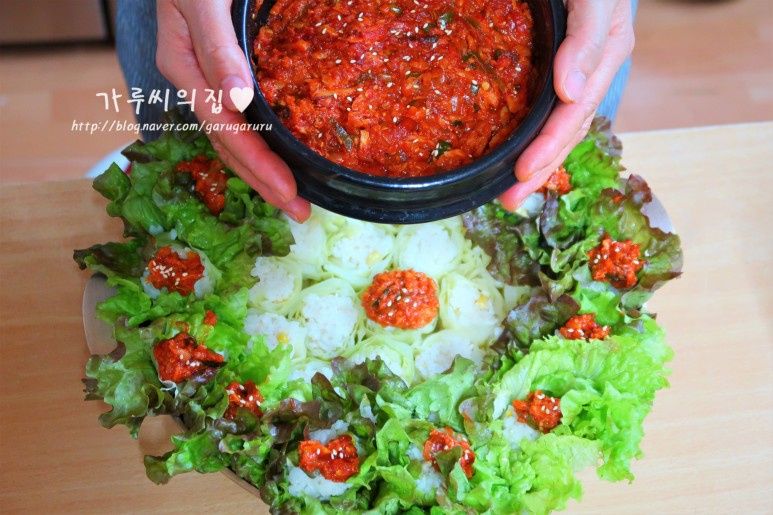Tuna Ssamjang (Korean Dipping Sauce)
Baek Jong Won’s Tuna Ssamjang Recipe: Perfect for Cabbage Wraps & Canned Tuna Dishes

This homemade tuna ssamjang is incredibly easy to make and tastes absolutely delicious. It’s a perfect addition to your home-cooked meals, elevating simple ingredients into a flavorful feast.
Ssamjang Ingredients- 1 can (approx. 150g) canned tuna
- 3 Tbsp Doenjang (Korean soybean paste)
- 3 Tbsp Gochujang (Korean chili paste)
- 1 large scallion (white parts preferred)
- 1/2 medium onion
- 1 red chili pepper
- 1 Korean green chili pepper (optional, for extra heat)
- 1 Tbsp Gochugaru (Korean chili flakes)
- 1/2 Tbsp sugar
- 1 Tbsp minced garlic
- 1/2 Tbsp crushed sesame seeds
- 1/2 Tbsp sesame oil
- 100ml rice water (water used to rinse rice)
Accompaniment Ingredients- Cabbage
- Lettuce
- Cooked rice
- Pinch of salt
- Pinch of sesame oil
- Crushed sesame seeds
- Cabbage
- Lettuce
- Cooked rice
- Pinch of salt
- Pinch of sesame oil
- Crushed sesame seeds
Cooking Instructions
Step 1
For a more detailed visual guide, please refer to the video above. (Link: https://youtu.be/TMYnfv5xWxQ)

Step 2
First, finely mince the onion, scallions, red chili, and green chili. Finely mincing these vegetables will help them blend smoothly into the ssamjang as it cooks, creating a better texture.

Step 3
Drain the oil from the canned tuna using a sieve. *Do not discard the tuna oil! Save it separately, as it will be used later to add extra flavor and richness to the ssamjang.

Step 4
Preheat a ttukbaegi (earthenware pot) or a small pot over low heat. Add the reserved tuna oil (about 2 Tbsp). Once warm, add the doenjang (3 Tbsp), gochujang (3 Tbsp), minced onion (1/2 medium), and sugar (1/2 Tbsp). Stir-fry over medium-low heat for about 3-4 minutes until the onions become translucent and the ingredients are well combined. This process mellows the fermented flavors and enhances the savory notes.

Step 5
Once the onions are translucent and the mixture is fragrant, pour in the rice water (100ml). Add the minced scallions, gochugaru (1 Tbsp), and minced red and green chilies. Bring to a simmer over medium heat and stir occasionally until the ssamjang thickens to your desired consistency, usually about 5-7 minutes. The rice water helps to create a smoother texture.

Step 6
When the ssamjang reaches your preferred thickness, add the drained canned tuna. Stir gently to break up the tuna and incorporate it into the sauce. Cook for just another 1-2 minutes; overcooking the tuna can make it dry and crumbly.

Step 7
Check the consistency one last time. Turn off the heat, then stir in the crushed sesame seeds (1/2 Tbsp) and sesame oil (1/2 Tbsp). Mix well. Once cooled to room temperature, store the ssamjang in an airtight container in the refrigerator. It will taste even better after resting!

Step 8
To prepare the cabbage wraps, bring a pot of water to a rolling boil. Place the cabbage leaves in a steamer basket over the boiling water. Sprinkle about 50ml of rice wine (cheongju) evenly over the cabbage. Cover with a lid and steam over medium heat for about 10 minutes, or until tender. The rice wine helps to remove any raw cabbage smell and adds a subtle depth of flavor.

Step 9
Test the cabbage for doneness by piercing it with a chopstick. It should slide in easily, especially through the tougher core. Once cooked, rinse the cabbage leaves under cold water to stop the cooking process and cool them down.

Step 10
Prepare the rice for the wraps. In a bowl, combine cooked rice with a pinch of crushed sesame seeds, a pinch of salt, and a drizzle of sesame oil. Mix gently to season the rice. This lightly seasoned rice adds a lovely subtle flavor to each bite.

Step 11
Take a portion of the seasoned rice and place it onto a cooked cabbage leaf. Carefully roll the cabbage around the rice, similar to making a sushi roll. Once rolled, cut the cabbage rice wraps into bite-sized pieces, about 1.5 to 2 inches (3-4 cm) long.

Step 12
For lettuce wraps, gently bend the thick stem of a lettuce leaf to soften it, then roll the rice inside the leaf. This provides a different, fresh crunch compared to the cabbage wraps.

Step 13
Arrange the cut cabbage rice wraps in the center of a serving plate. Surround them with the prepared lettuce wraps, creating a visually appealing and abundant presentation.

Step 14
Finally, generously spoon the delicious tuna ssamjang into the center of the plate, over the wraps. Serve immediately and enjoy this delightful meal of wraps and flavorful dipping sauce!



